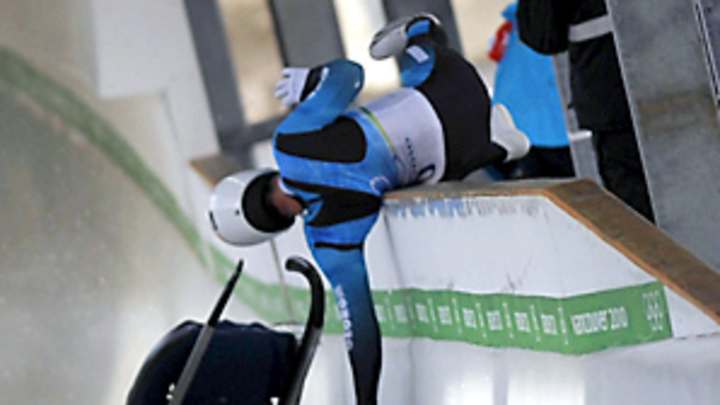Luge death shows danger of track

Bobsled, luge and skeleton athletes who have tested the course at Whistler in the last two years have widened their eyes when talking about the speeds generated on the track. Luge sleds generally peak in the mid-80s at other tracks but have hit the high 90s at Whistler. After a luger went a record 95.65 mph at a test event on the course last year, Josef Fendt, president of the International Luge Federation, expressed concerns that the track was too fast. "It makes me worry." Kumaritashvili's crash confirms those fears.
"It's not necessary to do the sport of luge at [96 mph]," says Christoph Schweiger, secretary general of the Austrian luge federation, who was at the course when Kumaritashvili's accident occurred. "To do the sport [in the 80-85 mph range] is fast enough."
On Friday the International Olympic Committee (IOC) said that an investigation into the accident was underway. No decision had been made as to whether the first runs of men's singles luge would take place on Saturday afternoon as scheduled. "If I were an organizer here I don't know what I would do in this situation," Schweiger says.
John Furlong, head of the Vancouver Organizing Committee, said in a press conference that "Kumaritashvili came here to be able to feel what it's like to be able to call yourself an Olympian. We are heartbroken beyond words ... When we know the substance of what happened, you will know it."
Schweiger suggested that the speed and difficulty of the course could be particularly troublesome for less experienced athletes from countries that are not among the typical luge powerhouses. "Georgia is not a nation like Canada, Germany, USA, Italy or Russia," he said. "It's a nation with lower experience." Romanian luger Violeta Stramaturaru was knocked unconscious after slamming into several walls during a training run on Thursday, and even one of the world's most experienced lugers, gold-medal favorite Armin Zöggeler of Italy, crashed on curve 11 just hours before Kumaritashvili. He wasn't hurt.
Erin Hamlin, the 2009 women's world champion in luge said two weeks ago that the speed of the Whistler course "definitely makes you have to react instantly. Even sometimes when you know you can react fast, it's too late. If you get into trouble you have to instantly get yourself out of it, and at speeds like that it's really hard."
A member of the U.S. Luge Association told SI that he had been informed privately by Olympic organizers that the sliding course was not meant to be so fast. Luge generates the highest speeds of the three sliding sports -- bobsled and skeleton are the others -- and requires significant steering. As a result, athletes in the sport generally start younger than other sliders.
One U.S. slider says that some blame should be placed with Canadian Olympic organizers for not granting international athletes more access to the course before the Games. The Vancouver Organizing Committee did add extra training time for the sliding course because of its difficulty, but U.S. athletes told SI that they had had only around 40 practice runs, while the Canadians had hundreds. "The selfishness of the Canadian sliding federations just killed somebody," the athlete says. "We all know about keeping countries off the track [strategically], but at the world championships in Lake Placid [last year] they knew the course was difficult, so the track manager left the course open. We didn't always like that, but no one got hurt."
Even before Friday's tragedy, course access was a bone of contention. U.S. bobsled driver Steve Holcomb, reigning world champion in the four-man event, said last week that the unequal practice time motivated him all the more to beat the Canadians. In November, Holcomb was training at Whistler in a two-man sled when he crashed for the first time in two years. It came on curve 13, which he and teammates have christened the "50/50 curve" because only half of bobsled teams made it through right side up during a training day in early 2009. Holcomb doesn't consider Whistler to be the most dangerous course in the world -- he reserves that designation for Altenberg, Germany -- but he did say that the damage of a crash on the Canadian course is accentuated because of the speed. "Imagine tripping and falling down on the street," Holcomb wrote in an e-mail Friday. "Now jump out of a moving car at 90 mph. It's much worse at higher speeds." What's more, the Whistler course is fast almost from the start, thanks to a 20-degree drop at curve two, so even if a slider crashes earlier in the race, he or she is likely to be traveling at relatively high speed.
The day before luge training began in Whistler, Holcomb's teammate Steve Mesler recounted the first time he walked the course, in January 2009: "Most tracks start to flatten out a bit, but this one just kept dropping. Through curve 11, 12, 13, it just keeps dropping." Kumaritashvili lost control coming out of curve 16, the final turn of the course.
After Kumaritashvili's crash, traffic to the Whistler Sliding Centre was stopped. Some of the normally beaming venue workers in their aqua work shirts turned sullen as confirmation of Kumaritashvili's death spread. "I thought skydiving was crazy until I saw this," said one venue worker who was watching luge for the first time on Friday.
When asked what he and team coaches would tell Austrian athletes about the crash and how to move forward with the Games, Schweiger said he had no idea. "We have no experience in saying such bad things," he said.
